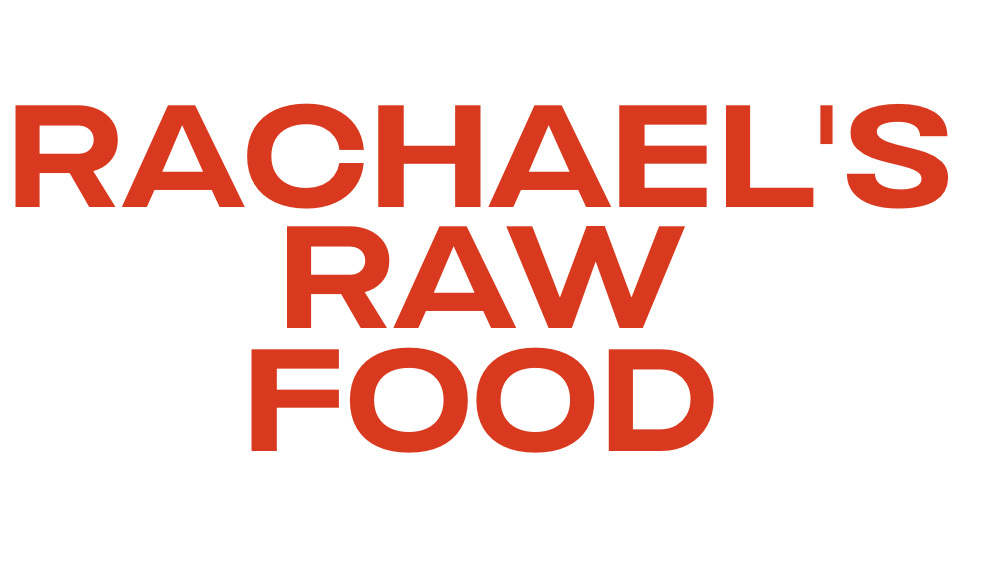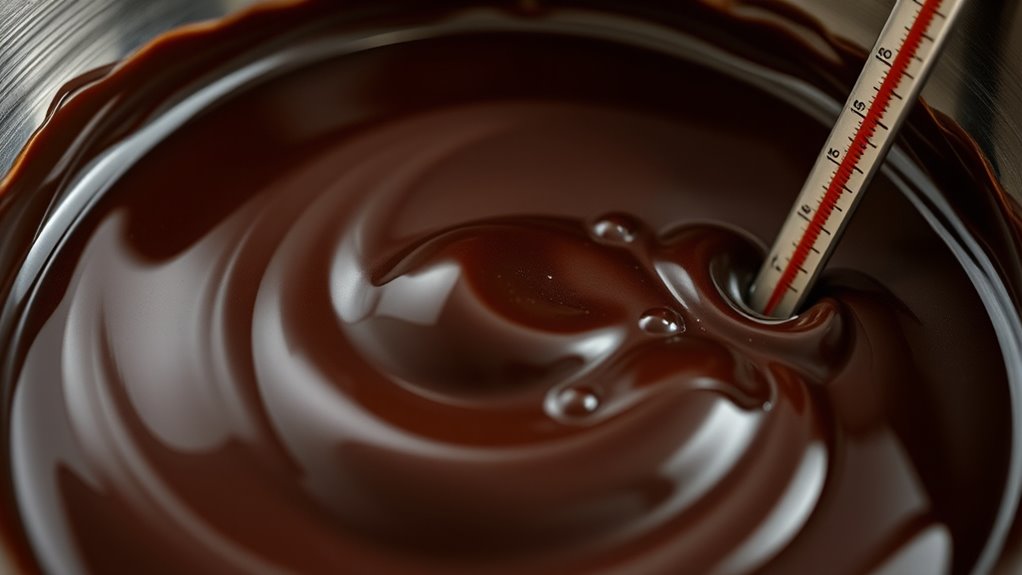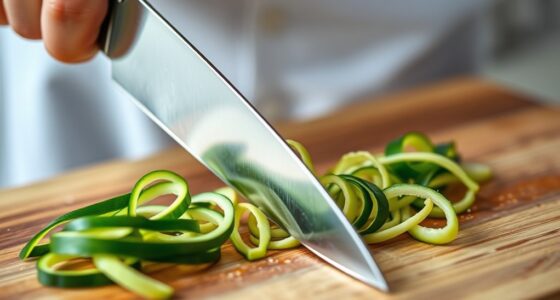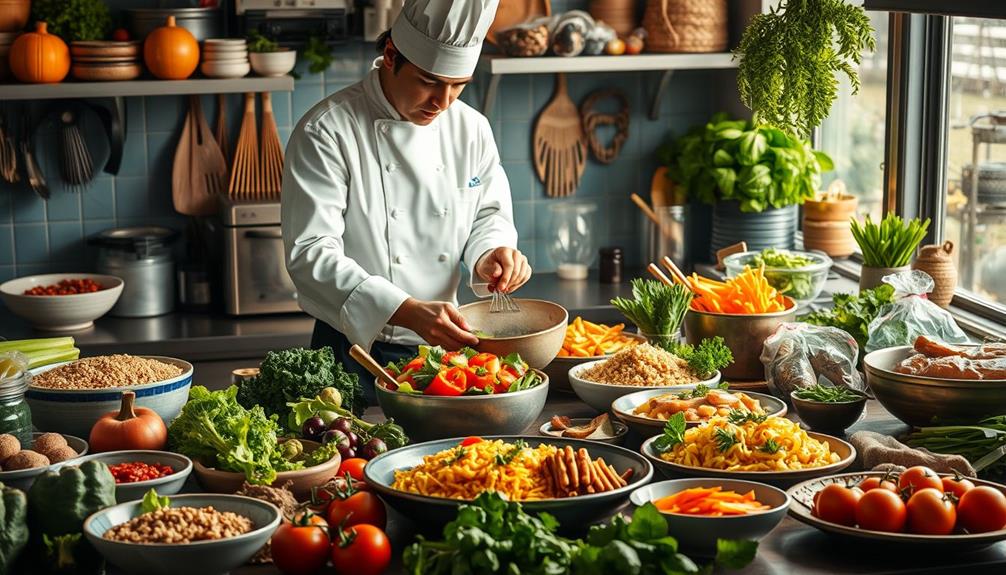To temper raw chocolate below 46°C for a perfect snap and shine, gently heat the chocolate until it reaches just below that temperature, then cool it while stirring to promote stable cocoa butter crystals. This process retains the chocolate’s natural antioxidants, vibrant flavors, and smooth texture. Controlling the temperature carefully prevents losing valuable nutrients and ensures a glossy finish. Keep in mind, mastering this technique helps highlight the true essence of raw cacao—discover how to perfect your approach next.
Key Takeaways
- Temper raw chocolate below 46°C to stabilize cocoa butter crystals, ensuring a glossy shine and satisfying snap.
- Proper tempering preserves antioxidants and flavor nuances unique to raw cacao.
- Gently heat and cool the chocolate while stirring to promote stable crystal formation.
- Maintaining temperature control is essential for achieving the desired texture and appearance.
- Correct tempering enhances mouthfeel, highlights cacao’s complex flavors, and produces professional-quality confections.
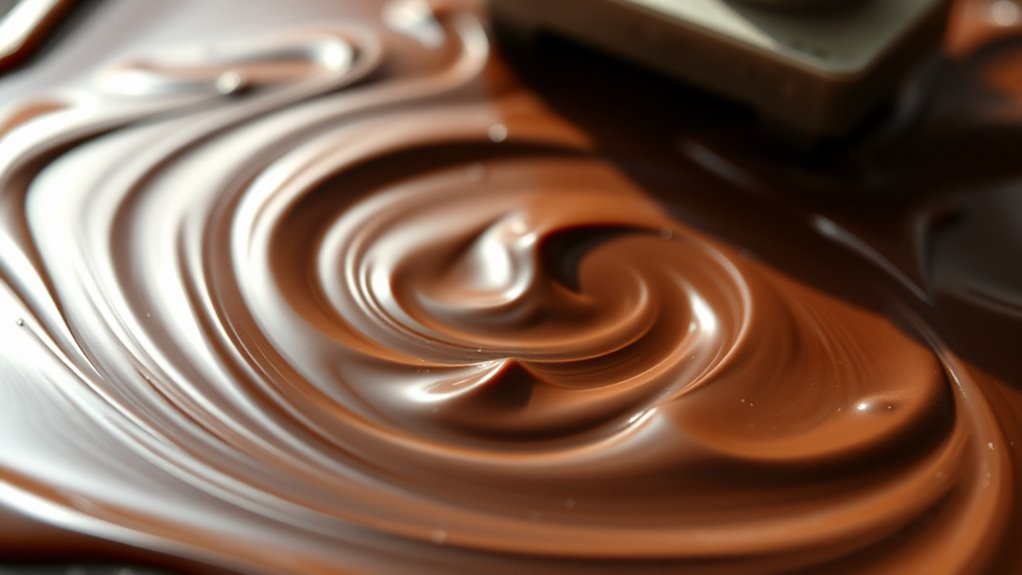
Raw chocolate, often celebrated for its rich flavor and health benefits, is made from unprocessed cacao beans that haven’t been roasted. This means the cacao bean processing retains much of the bean’s natural integrity, preserving antioxidants and subtle flavor nuances that are often lost during traditional roasting. When you explore raw chocolate, you’re diving into a world where the chocolate flavor profiles are more complex and vibrant, reflecting the true essence of the cacao bean. Unlike conventional chocolates, which often have a uniform, sweet taste, raw chocolate offers a more nuanced palette of earthy, fruity, and floral notes. Achieving this depth begins with understanding how cacao bean processing influences the final product.
One of the key steps in working with raw chocolate is mastering tempering below 46°C. Tempering is a delicate process that involves carefully heating and cooling the chocolate to stabilize its cocoa butter crystals. When you temper raw chocolate properly, you ensure it develops a glossy shine and a satisfying snap that’s characteristic of well-tempered confections. Unlike traditional tempering, which often involves higher temperatures, working with raw chocolate requires keeping the temperature below 46°C to preserve its delicate antioxidants and flavor compounds. This lower temperature range maintains the raw qualities, allowing you to enjoy the full spectrum of natural cacao flavors without compromising the health benefits.
As you begin to temper raw chocolate, you’ll notice that maintaining this low temperature helps the chocolate set with that perfect shine and firm snap. It takes patience and precision, but the payoff is worth it. When tempered correctly, raw chocolate not only looks appealing but also offers a better mouthfeel and texture. The process involves gently heating the chocolate until it reaches a specific temperature, then cooling it down while stirring to encourage crystal formation. This careful control ensures the cocoa butter forms stable crystals, giving your finished product that professional finish and satisfying crunch. Additionally, understanding the temperatures involved is crucial for achieving optimal results with raw chocolate.
In essence, tempering raw chocolate below 46°C is a crucial step in elevating your craft. It allows you to highlight the authentic cacao bean processing, which preserves the complex chocolate flavor profiles that set raw chocolate apart. By mastering this technique, you’ll produce chocolates that are visually stunning, with a glossy surface and a crisp snap, all while maintaining the healthful qualities that make raw chocolate a unique treat. Whether you’re making truffles, bars, or other confections, understanding how to temper raw chocolate properly is the key to achieving that perfect balance of appearance, texture, and flavor.
Frequently Asked Questions
Can Raw Chocolate Be Stored at Room Temperature Long-Term?
You can store raw chocolate at room temperature long-term if you keep it in a cool, dry place away from sunlight. Proper storage conditions are essential to maintain its quality and extend its shelf life. Make sure it’s in an airtight container to prevent moisture and odors from affecting it. With good storage, your raw chocolate can stay fresh for several months, allowing you to enjoy its flavor and texture over time.
What Are Common Mistakes When Tempering Raw Chocolate?
When tempering raw chocolate, you often make mistakes like not maintaining temperature stability, which disrupts proper crystal formation. If you heat or cool it too quickly, you risk uneven crystals, resulting in a dull finish or poor snap. Always monitor the temperature carefully and avoid sudden changes. This helps guarantee the chocolate develops the right crystal structure, giving you that glossy shine and satisfying snap you desire.
How Does Humidity Affect Tempering Raw Chocolate?
Did you know that even a 5% increase in humidity can significantly impact chocolate tempering? Humidity impact is vital because moisture control becomes difficult, causing the chocolate to seize or develop a dull surface. When you work in humid environments, the moisture can disrupt the crystal structure, preventing proper tempering. To avoid issues, keep your workspace dry and use silica gel packs to maintain ideal conditions, ensuring a shiny, crisp finish.
Is It Safe to Re-Temper Chocolate Multiple Times?
Yes, re-tempering chocolate multiple times is safe if you follow proper procedures. Re-tempering helps maintain chocolate stability, ensuring it stays glossy and snaps well. Just be cautious not to overheat or introduce moisture, which can cause blooming or spoilage. Always monitor temperature closely, and re-temper only when necessary. This way, you preserve the quality, safety, and perfect texture of your chocolate, making it ideal for your culinary needs.
Can Raw Chocolate Be Tempered Using Alternative Methods?
You can explore alternative tempering techniques for raw chocolate, like seed tempering or gentle heating methods, to achieve that perfect snap and shine. These approaches often involve ingredient substitutions, such as using cacao butter or specific temperature controls, making the process more adaptable. By experimenting with different methods, you can find what works best for your raw chocolate, ensuring it remains smooth, glossy, and deliciously satisfying.
Conclusion
So, there you have it—your crash course in raw chocolate tempering. Now, armed with the knowledge of keeping it below 46°C, you can impress friends with your “culinary expertise” and achieve that irresistible snap and shine. Who knew that melting chocolate was a delicate dance, not just a kitchen mishap? Go forth, temper like a pro, and revel in the satisfying crispness that screams, “Yes, I’ve mastered the art of raw chocolate.”
